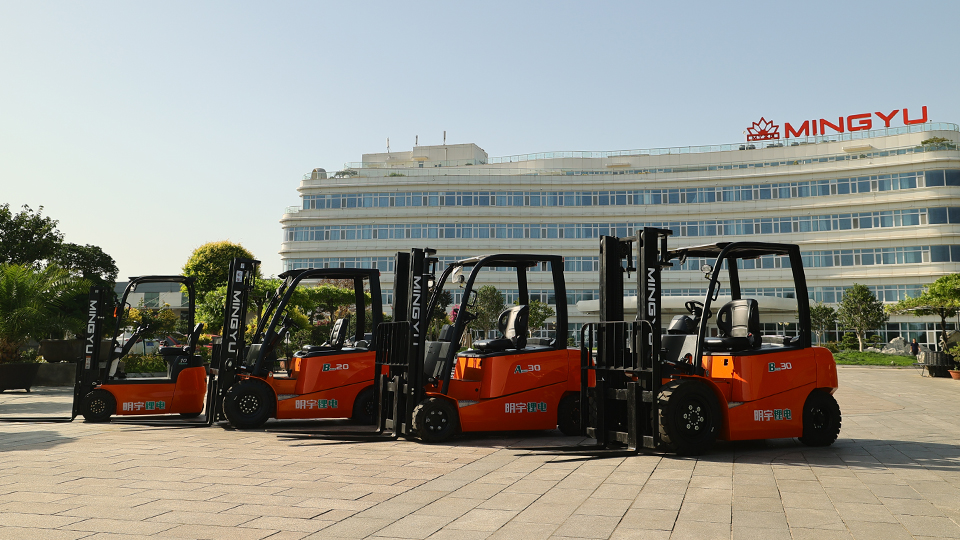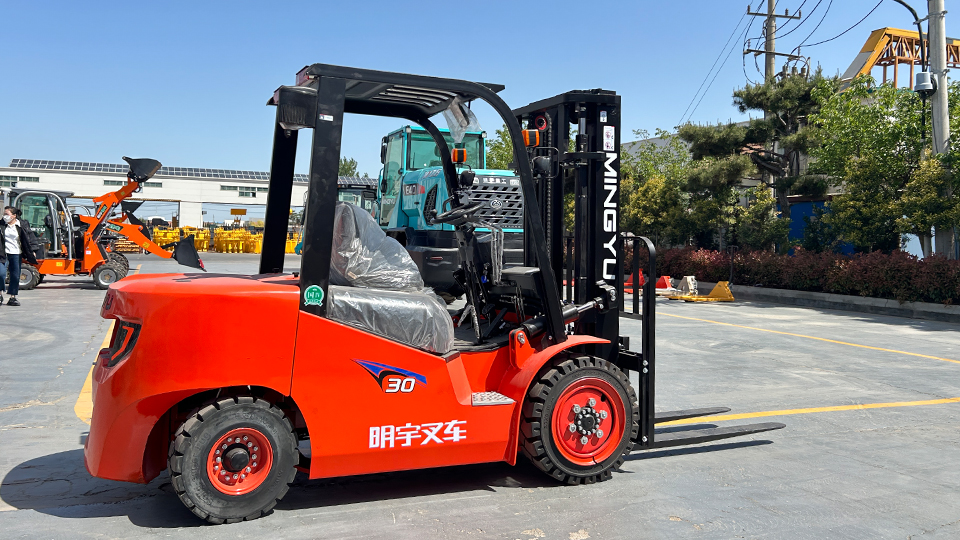
Are Electric Forklifts Good? An In-Depth Analysis of Their Advantages
Abstract
The question "Are electric forklifts good?" is increasingly being answered with a resounding "yes" across diverse industries. Once limited by battery technology and power output, modern electric forklifts have evolved into highly capable, efficient, and environmentally superior material handling solutions. This article will delve into the multifaceted advantages of electric forklifts, covering their environmental benefits (zero emissions, reduced noise), lower operational and maintenance costs, enhanced safety features, improved operator ergonomics, and technological advancements that are rapidly addressing historical limitations. By providing a thorough technical examination of these benefits, this article aims to demonstrate why electric forklifts are not merely "good" but often the optimal choice for contemporary material handling operations.
1. Introduction: The Shifting Paradigm in Material Handling
For decades, internal combustion (IC) engine forklifts dominated the material handling landscape, valued for their raw power and quick refueling. However, the dawn of the 21st century has ushered in a new era, with electric forklifts rapidly gaining market share and becoming the preferred choice in an expanding array of applications. This shift is not merely a trend but a fundamental re-evaluation of efficiency, sustainability, and operational costs. The question "Are electric forklifts good?" now probes beyond simple functionality, encompassing environmental impact, long-term economic viability, and workplace quality. This article will articulate the compelling advantages that position electric forklifts as a superior solution in many modern material handling environments.

2. Environmental Superiority: A Breath of Fresh Air
One of the most undeniable advantages of electric forklifts is their profound positive impact on the environment and indoor air quality.
Zero Emissions at the Point of Use:
Indoor Air Quality: Unlike IC forklifts that emit harmful pollutants such as carbon monoxide (CO), nitrogen oxides (NO
), hydrocarbons, and particulate matter (PM2.5), electric forklifts produce zero tailpipe emissions. This is critical for indoor environments like warehouses, food processing plants, and pharmaceutical facilities, where maintaining air quality is paramount for employee health and product integrity. Eliminating these pollutants reduces the risk of respiratory issues, carbon monoxide poisoning, and compliance violations with occupational safety standards.
Greenhouse Gas Reduction (Well-to-Wheel): While electricity generation may produce emissions at the power plant, the "well-to-wheel" emissions profile of electric forklifts is generally significantly lower than IC models, especially when electricity is sourced from renewable energy. This contributes directly to corporate sustainability goals and reduces a company's carbon footprint.
Reduced Noise Pollution:
Improved Work Environment: Electric motors operate with significantly less noise compared to internal combustion engines. This drastic reduction in noise levels creates a quieter, more comfortable, and less fatiguing work environment for operators and other personnel.
Enhanced Communication and Safety: Lower noise levels facilitate clearer communication, reducing the need for shouting and potentially improving awareness of pedestrian traffic or other equipment, thereby contributing to overall workplace safety. Noise reduction also helps meet occupational noise exposure regulations.
Reduced Fluid Waste and Spills: The absence of engine oil, coolant, and fuel eliminates the environmental risks associated with their storage, handling, and disposal. This significantly reduces the potential for hazardous spills and simplifies waste management protocols.

3. Lower Operating and Maintenance Costs: The Economic Imperative
Beyond environmental benefits, the economic advantages of electric forklifts are a primary driver of their widespread adoption.
Significantly Lower Fuel Costs (Electricity vs. Fossil Fuels):
Energy Efficiency: Electric motors are inherently more energy-efficient than internal combustion engines, converting a higher percentage of input energy into usable work.
Cost of Electricity: Electricity is generally more stable and less expensive than gasoline, diesel, or LPG. The cost per hour of operation for an electric forklift is considerably lower, especially in regions with favorable electricity rates. This translates into substantial savings over the forklift's lifespan, particularly for multi-shift operations.
Energy Management Systems: Advanced charging solutions and energy management systems can optimize charging times to leverage off-peak electricity rates, further reducing energy expenses.
Reduced Maintenance Requirements and Costs:
Fewer Moving Parts: Electric forklifts have significantly fewer moving parts compared to IC engine forklifts. There's no engine, transmission, spark plugs, fuel injectors, radiators, exhaust systems, or engine oil to change.
Elimination of Engine-Related Maintenance: This translates to the elimination of routine engine oil changes, filter replacements (oil, fuel, air), coolant flushes, spark plug replacements, and complex engine tune-ups.
Longer Service Intervals: Components like electric motors and control systems often have longer service intervals than engine components.
Lower Labor Costs: Fewer maintenance tasks lead to reduced labor hours spent on servicing, further contributing to cost savings.
Less Downtime: The simplified maintenance schedule means less time the forklift spends in the service bay and more time on the floor, directly improving productivity and reducing the need for backup equipment.
Investment Tax Credits and Incentives: In many regions, governments and utility companies offer tax credits, rebates, or grants for investing in electric vehicles and charging infrastructure, further reducing the total cost of ownership.
4. Enhanced Safety Features and Workplace Quality
Electric forklifts contribute to a safer and more comfortable work environment in multiple ways.
Improved Visibility: The absence of large engine components often allows for more compact designs and lower counterweights, potentially improving rear and side visibility for the operator.
Reduced Vibration: Electric motors produce significantly less vibration than IC engines, leading to reduced operator fatigue and a more comfortable ride, particularly over long shifts. This can also reduce wear and tear on the forklift's components.
Precise Control and Maneuverability:
Smooth Acceleration and Deceleration: Electric motors provide instant torque and very smooth, precise acceleration and deceleration, leading to better control, especially in tight spaces or when handling delicate loads.
Regenerative Braking: Many electric forklifts feature regenerative braking, which not only recharges the battery during deceleration but also reduces wear on the mechanical brake components, extending their lifespan and requiring less frequent maintenance. This also provides fine control over stopping.
Compact Design: The ability to design smaller, more compact chassis (especially with lithium-ion batteries) enhances maneuverability in narrow aisles and congested areas, reducing the risk of collisions.
No Fuel Storage Hazards: Eliminating gasoline, diesel, or LPG storage removes associated fire and explosion risks, simplifying safety protocols and reducing the need for specialized flammable material storage facilities.
Automatic Shut-off: Many electric forklifts incorporate advanced safety features such as automatic shut-off when the operator leaves the seat, speed limiting based on load or location, and advanced stability control systems.
5. Technological Advancements and Performance Capabilities
Modern electric forklift technology has addressed many historical limitations, making them highly competitive with IC models.
Powerful AC Drive Systems: Contemporary electric forklifts predominantly use AC (Alternating Current) motors, which are more powerful, more efficient, and require less maintenance than older DC (Direct Current) motors. AC motors provide strong acceleration, excellent ramp performance, and sustained power output.
Lithium-Ion Battery Revolution:
Fast Charging: Lithium-ion batteries can be opportunity charged during breaks, significantly reducing downtime and often eliminating the need for spare batteries. They can be fully charged in 1-2 hours.
Maintenance-Free: Unlike lead-acid batteries, lithium-ion batteries are sealed and require no watering or specific ventilation during charging, simplifying maintenance and improving safety.
Longer Lifespan: Lithium-ion batteries offer a significantly longer cycle life than lead-acid, reducing the frequency and cost of battery replacements over the forklift's operational life.
Consistent Performance: Lithium-ion batteries maintain consistent voltage output throughout their discharge cycle, meaning the forklift's performance remains strong until the battery is nearly depleted, unlike lead-acid batteries which experience "fade."
Energy Density: Higher energy density allows for more compact battery designs, contributing to overall forklift compactness and potentially improving residual capacity.
Advanced Control Systems: Sophisticated electronic control systems optimize power delivery, enhance diagnostics, and allow for customizable performance parameters (e.g., speed limits, acceleration rates) to match specific application requirements and operator skill levels.
Data Telematics Integration: Many electric forklifts come with integrated telematics systems that monitor battery status, operational hours, impact events, and other key performance indicators. This data enables proactive maintenance, optimizes fleet utilization, and provides valuable insights for operational improvements.
6. Suitability for Specific Applications
Electric forklifts are particularly well-suited for a variety of applications where their specific advantages are paramount.
Indoor Operations: Their zero emissions and quiet operation make them ideal for warehouses, distribution centers, manufacturing facilities, cold storage, and food processing plants.
Food and Pharmaceutical Industries: The absence of exhaust fumes and fluids reduces the risk of contamination, crucial for maintaining hygiene standards.
Retail and Consumer Goods: Quiet operation is beneficial in retail environments where customers may be present.
Multi-Shift Operations (with Lithium-Ion): With lithium-ion technology, electric forklifts can seamlessly support 24/7 operations through rapid opportunity charging, eliminating the need for battery changes.
High-Density Storage: The compact size and precise control of electric reach trucks and very narrow aisle (VNA) trucks are essential for optimizing space utilization in modern warehouses.
7. Overcoming Historical Disadvantages
It's important to acknowledge that many historical "disadvantages" of electric forklifts, such as limited run times, slow charging, and insufficient power, have been largely mitigated or completely overcome by recent technological advancements, particularly with the advent of lithium-ion batteries and advanced AC drive systems. While initial cost remains higher, the total cost of ownership often demonstrates a clear economic benefit over the forklift's lifespan.
8. Conclusion: The Smart Choice for the Modern Era
To reiterate, "Are electric forklifts good?" The answer is unequivocally yes, and in many cases, they are demonstrably better than their internal combustion counterparts. Their superior environmental performance, significantly lower operating and maintenance costs, enhanced safety features, and improved operator ergonomics make a compelling case for their adoption. Furthermore, the rapid advancements in battery technology, particularly lithium-ion, have effectively addressed many of the historical concerns regarding charging time and power limitations, positioning electric forklifts as a robust and versatile solution for a vast majority of material handling applications.
For businesses looking to reduce their carbon footprint, improve indoor air quality, cut operational expenses, and enhance workplace safety and efficiency, investing in electric forklifts is not just a good choice—it is a strategic decision that aligns with the demands and opportunities of the modern industrial landscape. As technology continues to evolve, the advantages of electric forklifts are only set to grow, solidifying their position as the future of material handling.
Name: selena
Mobile:+86-13176910558
Tel:+86-0535-2090977
Whatsapp:8613181602336
Email:vip@mingyuforklift.com
Add:Xiaqiu Town, Laizhou, Yantai City, Shandong Province, China